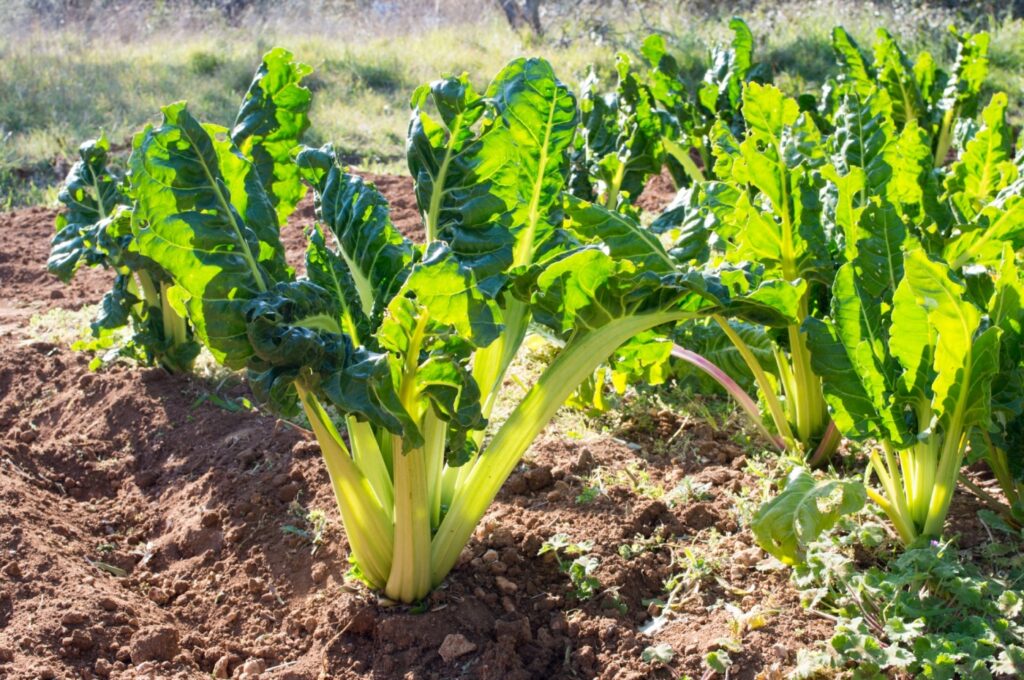
1. You can plant Swiss chard throughout the year. Its seeds, like those of closely related beets (they are varieties of the same species, Beta vulgaris), are formed in clusters, up to four seeds per cluster. Soak clusters for 15 minutes in warm water prior to planting in a full to partial-sun location. Swiss chard is a Mediterranean plant but owes its name to a botanist who wanted to draw a distinction between it and French spinach or orach, another chard family member. The naming botanist called it “Swiss” simply because he came from Switzerland. “Chard” is another name for cardoon, a wild relative of the artichoke. What do cardoon and chard have in common? The edible portion of cardoon is its stem, just as chard has an edible stem although, in its case, leaves are eaten too. Giant Fordhook is a classic heirloom Swiss chard variety while the Sunset series includes plants with magenta, yellow-orange, and white stems. A variety with white stems and white-veined leaves is also available.
2. If you have a myrtle shrub (Myrtus communis), you will notice its large clusters of berries at this time of year, which grew from glittering white flowers with golden stamens that bloomed in the summer. Although there is no botanical relationship between the plants on which they grow, myrtle berries look remarkably like blueberries and are equally edible, if not nearly as sweet. Myrtle leaves may also be used in cooking as a substitute for bay leaves. You can create a lifetime supply of bay leaves in just a few years by planting a bay laurel (Laurus nobilis), available at most nurseries in the herb section. Both myrtle and bay laurel are Mediterranean plants that can grow without water once established although bay laurel, when young, will benefit from afternoon sun protection whereas myrtle can handle full sun exposure even when young. Both plants also may be grown as hedges.
3. In the United Kingdom, trends for gardening in 2023 include experimenting with seaweed as a substitute for peat moss, as the sale of peat moss, a diminishing resource, will be banned there in 2024. The legality of harvesting seaweed from the ocean may be in question, but that which washes up onto the shore – ideally, mid-beach – is free to take. You might think of rinsing it off in order to remove ocean salt, but this practice is not recommended because you may also remove valuable micronutrients in the process. Liquid seaweed has long been used as a fertilizer on account of the wide spectrum of its mineral elements, each vital to plant growth. Before using it as a soil amendment, seaweed does not require composting but only needs to be dried and shredded or chopped up into fine pieces. Another UK gardening trend finds Cymbidium and Dendrobium orchids finding their way indoors due to cooler home temperatures – which these orchids, as opposed to other orchid types, require – because of the increasing price of heating our residences. Creating the proper ambiance for growing these orchids is the horticultural benefit derived from cutting back on the hours we can afford to run central heating.
Related Articles
How to combat erosion in your garden with plants, terracing
What to know about herbicides before using in your garden
Finding inspiration for pollinator-friendly home gardens at The Living Desert
The joys of a semi-dwarf navel orange tree and other hardy citrus with winter fruit
In sodden California, few homeowners have flood insurance
4. To save the expense of buying gift bouquets at the florist shop, plant flowers that have strong stems and bloom over a long period of time so that you can craft your own bouquets. Nearly all plants that grow from bulbs, rhizomes, tubers, or corms qualify in this respect, including ranunculus, gladiolus, daffodil, narcissus, dahlia, daylily, agapanthus, and ornamental onion. Keep in mind that you can still order bulbs for spring blooming from online vendors. Other candidates with bouquet-suitable flowers include roses, of course, ornamental sages (Salvia spp.), sweet peas, Shasta daisy, cosmos, sunflowers (there are many colors and heights from which to choose), and delphinium.
5. While rain can cause erosion and mudslides, especially when it comes down in buckets, we should also be aware of what it may bring to our gardens in its wake and prepare accordingly. There is likely to be a proliferation of weeds and insects, which will feast on inordinately succulent growth brought on by excessive rain. This rapid growth comes from the fact that air is 78 percent nitrogen and nitrogen, above all other elements, is what makes plants green. Some of this element, in its nitrate and ammonium forms, comes down in the rain and is immediately taken in by plants through roots and leaves. Heavy rain is often a problem in water ponds and pools because it will cause explosive growth of algae and other undesirable water plants due to the sudden influx of nitrogen. Pull weeds as soon as they appear and, if you must spray insect pests because of an overwhelming infestation, utilize horticultural soaps or fine oils. Often beneficial insects arrive to control an insect pest just when you think spraying is the only way to control your uninvited guest.
Please send questions, comments, and photos to joshua@perfectplants.com.
